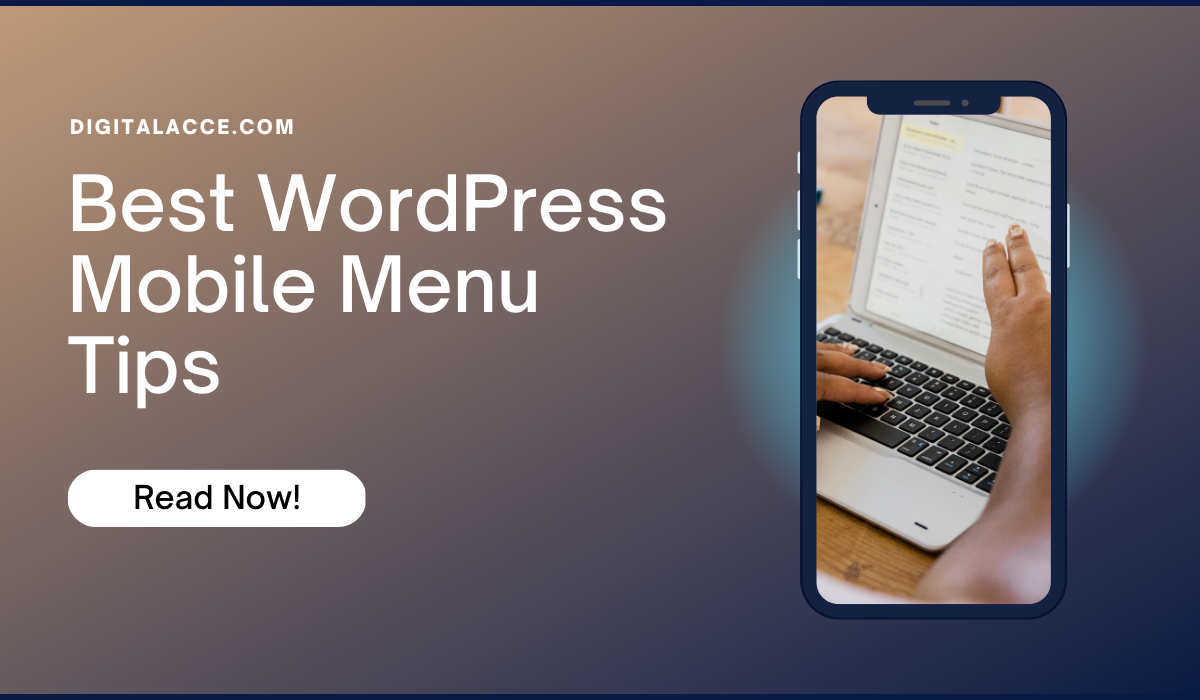In today’s digital age, mobile devices have become the primary source of internet usage, and websites must adjust their design to accommodate these devices. As a WordPress user, you have probably noticed that your website’s mobile menu looks different from its desktop version. This difference is due to the responsive design technique for creating mobile menus optimized for smaller screens. However, with the right WordPress mobile menu tips, you can optimize your menu for smaller screens and provide a seamless user experience for your visitors.
In this blog post, I will cover the best practices for responsive design in mobile menus in WordPress. I’ll provide expert tips on designing and optimizing mobile menus to ensure visitors have a seamless and satisfying user experience.
By the end of this post, you will clearly understand the importance of responsive design in mobile menus and how to implement the best practices for your WordPress website.
Contents
Understanding Responsive Design
Responsive design is a web design approach that enables websites to adjust their layout based on the screen size and orientation of the device used to view them.
Regarding mobile menus in WordPress, responsive design ensures that the menu is optimized for smaller screens, making it easier for users to navigate your website on their mobile devices.
Responsive design is crucial for mobile menus for several reasons. Firstly, a responsive design approach ensures your menu will be user-friendly and easily accessible on all devices.
This is essential since many people use their mobile devices to browse the web. Secondly, responsive design can improve your website’s search engine optimization (SEO) since search engines favour mobile-friendly websites.
Despite the benefits of responsive design, there are common mistakes to avoid when designing mobile menus in WordPress. For example, overcomplicating your menu design can make it harder for users to navigate your site.
Similarly, placing your menu in an unusual or hard-to-find location can make it difficult for users to access it. It’s essential to keep your menu simple and prioritize important items while ensuring it is intuitive and easy to use on all devices.
Related: How Emails and Newsletters Mobile Responsive
Best WordPress Mobile Menu Tips for Responsive Design
When designing your mobile menu in WordPress, it’s important to keep several best tips in mind. By following these guidelines, you can create a mobile menu that is user-friendly and optimized for smaller screens.
Keep it Simple and Easy to Navigate
One of the essential best practices for mobile menus in WordPress is to keep your menu design simple and easy to navigate.
Mobile users are often on the go and want to find what they need quickly.
A cluttered and complicated menu can make it challenging for users to see what they want. Limit your menu items to the most important and frequently accessed pages to avoid this.
Additionally, avoid using drop-down menus or too many sub-menus, as they can be difficult to use on smaller screens.
Prioritize Important Menu Items
Another important best practice for mobile menus in WordPress is to prioritize important menu items. Since mobile screens are smaller, there’s limited space to display your menu items.
So, it’s essential to choose the most critical items to display. To determine the priority of menu items, consider what your visitors are looking for on your site and the most commonly accessed pages.
Use Intuitive Icons
Using icons is another best practice for mobile menus in WordPress. Icons are a great way to convey information in a compact and easily recognizable form. When selecting icons, make sure they are easy to understand and align with your website’s brand and style.
Choose the Right Placement
Choosing the right placement for your mobile menu is also essential for a responsive design. The most common placement is the hamburger menu icon, typically placed in the screen’s top left or right corner.
However, depending on your website’s design, it may be beneficial to place your menu icon in another location that is more prominent and easily accessible.
Optimize Menu Size and Typography
Lastly, optimizing your menu size and typography is essential for responsive design in mobile menus. Consider using a font size that is large enough to be easily read on a smaller screen, and choose a legible font style.
Additionally, keep your menu size small in terms of screen real estate and file size to ensure quick loading times.
Use clear and concise menu labels
Avoid using lengthy or complicated labels for your menu items. Instead, use clear, concise labels that accurately reflect the page or content they link to.
One way to do this is to use straightforward language that accurately reflects the content or page the label links to. For example, instead of using a long label like “Services and Products,” consider using separate labels for each, such as “Services” and “Products.”
Additionally, avoid using jargon or technical terms that may not be immediately understandable to all users. If your site offers a variety of products or services, consider using broad categories and subcategories to help organize and simplify the menu structure.
Design Considerations for WordPress Mobile Menus
When designing mobile menus in WordPress, it’s crucial to consider customization options and how to change your menu easily. Fortunately, WordPress offers a range of customization options that allow you to tailor your mobile menu to your site’s specific needs.
Customization Options in WordPress Mobile Menus
WordPress offers various customization options for mobile menus, such as choosing between different menu styles and placements. You can also customize your menu’s colour, typography, and layout to match your site’s branding and style.
How to Make Changes to the WordPress Mobile Menu
Changing your WordPress mobile menu is easy and can be done through the WordPress dashboard. To make changes, navigate to the “Appearance” section and select “Menus.” From there, you can add or remove menu items, change the order of menu items, and customize menu settings.
Using Plugins to Enhance WordPress Mobile Menus
WordPress plugins can help enhance your mobile menu’s functionality and appearance. Numerous plugins allow you to add features such as mega menus, drop-down menus, and mobile-friendly icons to your mobile menu.
However, it’s vital to choose plugins carefully and only use well-maintained and regularly updated ones to ensure compatibility with your site and avoid potential security risks.
Testing and Optimization
Creating a responsive and user-friendly mobile menu is crucial for providing a positive user experience on your WordPress site. However, testing and optimising your mobile menu regularly is equally important to ensure it performs optimally and meets your users’ needs.
Testing your mobile menu is essential for identifying usability issues, such as slow loading times or confusing navigation. By conducting regular testing, you can ensure that your menu is intuitive and user-friendly and identify areas that may need improvement.
Metrics to Track and Measure the Success of Your Mobile Menu Design
To measure the success of your mobile menu design, it’s important to track and analyze key metrics such as click-through rates, bounce rates, and user engagement. These metrics can help you identify how users interact with your mobile menu, which items are most popular, and which areas may need improvement.
Tools and Resources for Testing and Optimization
There are various tools and resources available that can help you test and optimize your mobile menu design.
Google Analytics is a powerful tool that provides detailed insights into user behaviour on your site. In contrast, heat mapping tools such as Hotjar can help you visualize how users interact with your mobile menu.
Additionally, A/B testing tools like Optimizely can test different variations of your mobile menu design to determine which performs best.
WordPress plugins like WP Mobile Menu and Responsive Menu offer additional customization options and can help you create a more functional and user-friendly mobile menu.
Conclusion
In today’s mobile-first world, responsive design is crucial for creating a user-friendly and functional mobile menu on your WordPress site. Following the best practices covered in this blog post, you can create a responsive and intuitive mobile menu that enhances the user experience and helps users find the content they want.
So, if you want to improve your WordPress mobile menu, implement these tips and strategies to create a more responsive and user-friendly design. Your visitors will thank you for it!
In case you run into any issues, and your WordPress mobile menu is not showing, read my detailed guide on how to fix it.
Thank you for reading this post on WordPress mobile menu tips. I hope you found it helpful and informative. If you have any questions or feedback, please feel free to comment below.



